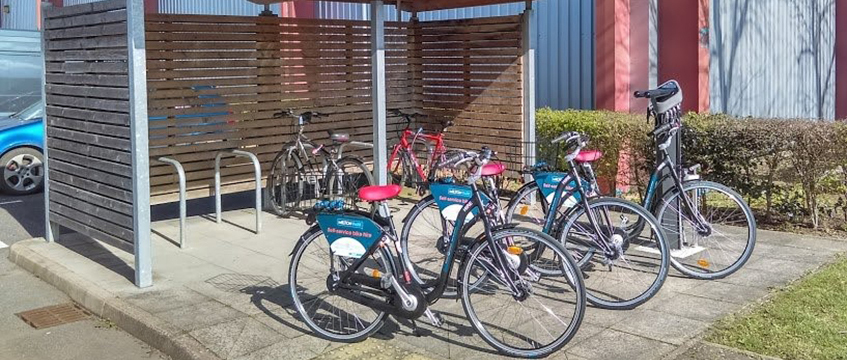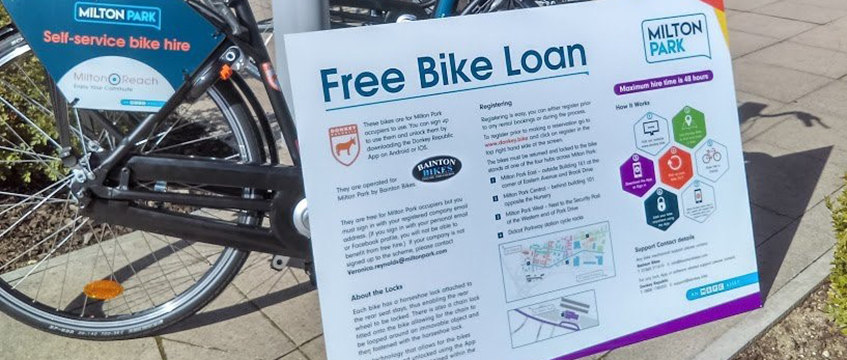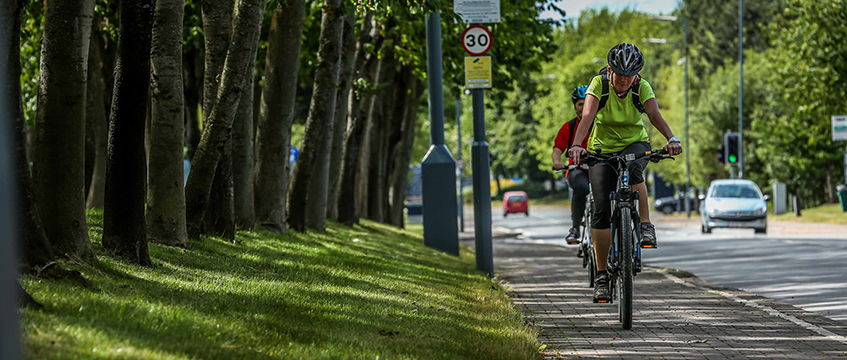“We challenged people to go car free for one day. One guy came on a unicycle.”
Philip Campbell, commercial director at MEPC, is talking about the firm’s green transport strategy at the 250-acre Milton Park in Oxfordshire.
Using one wheel to commute no doubt wasn’t what the developer anticipated but it certainly got a lot of attention, and that is key, says Veronica Reynolds of transport consultant Vectos, who is advising MEPC on its green transport strategy at Milton Park.
“People are most likely to do something if they see others doing it. If there are visual clues like seeing a bike shelter or seeing car sharing bays,” says Reynolds, whose background is in behavioural psychology.

A lift-share scheme has been introduced at the park, with preferential parking for those taking part, as well as having loan bikes, enhanced cycling facilities and routes. A recent survey of occupiers at the park found that in the past 12 months there had been a 14% increase in shared journeys and a 5% increase in cycling.
But having a green transport strategy can add value beyond health and environmental benefits. MEPC sees it as an important part of future-proofing the park.
“What we could see coming down the road was an increasing urbanisation of the area and we felt the need to make a step change on the green transport strategy,” says Campbell.
Not all business parks are facing the same urbanisation issue, but supporting a variety of ways of commuting and greener transport increasingly influences occupier interest.
Phil Wade, development manager for Bridgwater Gateway, a new 100 acre business park in Somerset says: “At the moment it’s on the agenda [for potential occupiers] but not a key decision influencer, but when they are making their mind up its another reason to say ‘yes’ rather than say ‘no’.
James Latham, associate, Carter Jonas, which is agent on Oxford Science Park says: “When people are applying for jobs they are looking at the environment they are going to work in. As well as facilities, they look at how they are going to get there and staff turn down jobs because they can’t get to a location.”
Oxford Science Park has long had an ethos of green transport initiatives but Latham says it has to keep up with the times, which is why it has just signed up for a cycle hire docking system similar to that used in London.
“We want to be championing schemes like this as a science park, it differentiates the park,” he says.
Alternatives to driving
Back on Milton Park there is a definite demand from occupiers for alternative means of commuting to the traditional car.
Reynolds explains: “We have a lot of European companies and they are used to being able to cycle and use public transport, and millennials are used to not owning a car. Businesses want to be able to employ and recruit from nearby towns, people that don’t own cars.”
She adds that the park certainly isn’t anti car. “We wanted to make small changes that prepare Milton Park for the future and provide a place that is accessible for everyone not just those who have a car.”
It is something Rob Peill, head of offices at Property Alliance Group, also believes is important at the two business parks it owns and manages: Trident at Manchester Airport and Towers at Didsbury. Green transport plans include electric charging points, free shuttle buses and enhanced cycling facilities.
Peill says: “Implementing these measures ensures we can meet the needs of a growing number of larger occupiers and institutional investors, which are all demanding green transport strategies at business parks.

“Long-term, there are other benefits too. In our experience, we have also found that these measures play a key role in helping tenants to attract and retain staff. On-site facilities and more accessible public transport provide more convenience for employees, and increasingly the younger generation expect their employers to be doing more to protect the environment.”
Utilising free space
A pleasant side effect to green transport initiatives and in particular car sharing is an increased sense of community.
In fact Toby Saul, asset manager, Canmoor Asset Management says it is one of the key benefits of its green transport strategy at the 148-acre Birmingham Business Park. The park signed up for a car share scheme with neighbours NEC and Birmingham airport, which already has 100 members. The ‘buddying up’ means occupiers are getting to know their neighbours as well as saving money on their commute costs.
“We are holding an increasing number of events,” he says.
The park is also promoting walking and cycling, with pool bikes for popping to the café and shops on the park and improving facilities such as adding showers to buildings as they refurbish them. It is also working with Cycle UK to run cycling lessons, offer bike maintenance workshops and security marking.
Another potentially valuable side effect of offering alternatives to ‘one person one car’ is freeing up land from road and parking to use for other things. Autonomous vehicles could be the big driver – if you’ll excuse the pun – of this in the future, but there are already signs of change.
MEPC, for example, has created amenity space on an overspill car park that is no longer used.
Carter Jonas’s Latham says there are a variety of option that can be explored but it will come down to how you want to use the land.
“Whether you want to intensify the use of land you can do that but can also use it for amenities, open space etc. The property part of the equation is not the driver for the deal it’s the environment that you put them [the occupier] in that is most important.”
Green emphasis from the start
The 100 acre Bridgwater Gateway Business Park off junction 24 of the M5 in Somerset has consent for 1m sq ft of space which includes office, high tech industrial, two hotels and leisure offer.
It is still under construction, but green transport strategies have been a feature from the start.
Phil Wade, development manager for Bridgwater Gateway says: “It’s not about offices with a bit of green space, it’s about making sure the facilities are there in a fully encompassed way. Can your staff get to the office by walking or by bike. Is there a way they can commute in a green way.
“We are putting in electric charging points. If we don’t do these things it will affect value, not in a describable way today but tomorrow it might.”
Aside from electric charging points, footpaths and cycleways are part of the design, as are cycle storage and bus stops.
Future disruptors
The biggest advance in transport that could have an impact on the property industry is autonomous vehicles.
Trials started last year in urban areas and in 2019 trials on motorways are expected to begin.
It is not just the potential for fewer parking space as vehicles drop occupants off and then park up more efficiently, but also for less car ownership.
Cars spend more time parked than in use but technological advances mean in the future, rather than owning a car, you could instead subscribe to a car service booking via an app whenever and wherever you needed. An autonomous vehicle would collect and deliver passengers before moving onto the next job.
Fewer cars, more efficiently used, potentially means less congestion, less road space and less parking, which opens up more land for public realm, community facilities and development.
Car-share schemes for commuting are already popping up all over the country but if this technology and data was combined with autonomous vehicle services it could become more flexible and convenient.
To send feedback, e-mail stacey.meadwell@egi.co.uk or tweet @EGStaceyM or @estatesgazette











